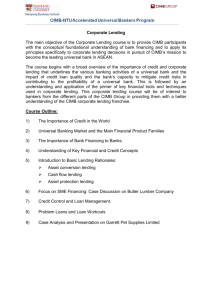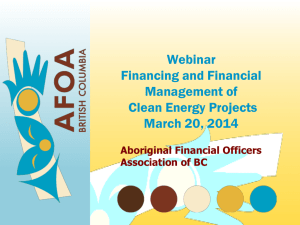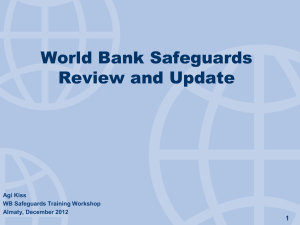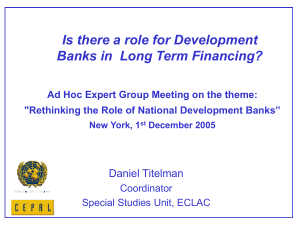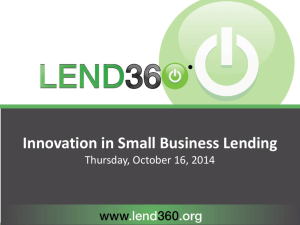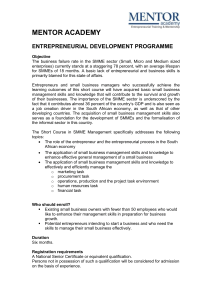direct lending market position
advertisement
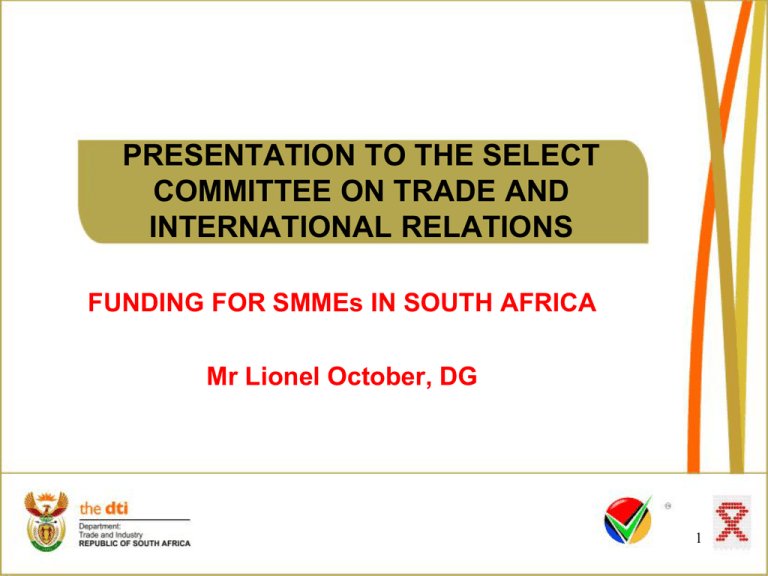
PRESENTATION TO THE SELECT COMMITTEE ON TRADE AND INTERNATIONAL RELATIONS FUNDING FOR SMMEs IN SOUTH AFRICA Mr Lionel October, DG 1 INDEX • HISTORICAL PERSPECTIVE • GOVERNMENT’S TARGET MARKET • GOVERNMENT’S DIRECT LENDING TARGET MARKET • THE SMME FINANCING LANDSCAPE • DIRECT LENDING MARKET POSITION • DFI SUPPORT CHALLENGES • INTERVENTION BY GOVERNMENT – DFI CHALLENGES • REFLECTION ON THE CURRENT SCENARIO • FUTURE CONSIDERATIONS AND THE WAY FORWARD 2 HISTORICAL PERSPECTIVE • Since the decision by government to intervene in the SMME sector in 1995, SMME funding have been one of the critical element of support • Based on this quite a number of programmes in and outside the dti family of institutions have been developed • Pioneering these was the establishment of Khula Enterprise Finance in 1996 • Government intention has been to address the market failure as opposed to taking the entire share of the funding market 3 HISTORICAL PERSPECTIVE CONT. • The State envisaged itself as a facilitator of private sector financing to SMMEs rather than the primary driver, relying on the overriding assumption that the commercial banking sector and other financing institutions would be attracted to address the SME financing needs if they were backed by government guarantees • A high expectation was that government intervention will crowd in the private sector funding to the sector • This was to be enhanced later through the B-BBEE Financial Sector Charter • The above however, did not happen as expected 4 GOVERNMENT TARGET MARKET Loan sizes in the range of R10K-R3m, with particular emphasis on facilities less than R1m, especially <R250k Start-up and development / expansion capital Bias towards underserved provinces / rural / townships Primarily Blackowned ownermanaged formal SMEs Underserved segments of the SME market GOVERNMENT’S DIRECT LENDING TARGET MARKET o SMEs operating in low economic activity areas o Start-ups and early expansion businesses o Primarily bridging and working capital finance (no tangible security) o Primarily black owned and managed enterprises o Priority to women owned and managed enterprises 6 THE SMME FINANCING LANDSCAPE Driver Category Characteristics Nature of Demand Source of Funding Number of Enterprises Medium Less than 200 employees Medium to long term debt & Corporates equity Banks/Financial Institutions Over R250k Private Equity/Venture Asset based, working capital, Turnover > R25m p.a. Opportunity Driven Entrepreneurial Developed technical & business skills Small Capitalists property finance etc. Khula , IDC, NEF , Other DFIs Less than 50 employees Short to medium term debt Own resources Turnover < R25m p.a. Asset based & working capital Banks & Corporates Developed technical /limited business Up to R250k Khula & Provincial skills Micro 0,1 – 0,3m 0,2 – 0,5m Development Corporations Less than 5 employees Short term loans Own & family resources Turnover < R150k p.a. Up to R10k Micro-lenders & Banks Some technical /limited business skills Working capital SAMAF & Provincial 0,6 – 1,0m Development Corporations Necessity Driven Survival Survivalists Individual self employment Short term loans Turnover < R50k p.a. Up to R3k Limited technical and business skills Stock purchases Own & family resources 0,7 – 1,2m Micro-lenders SAMAF 7 DIRECT LENDING MARKET POSITION Low Banks Credit Indemnit y High Equity Investors (JVs & SME Funds) Loan Amou nt Risk RFIs (Business Loans for onlending to SMEs) High KhulaDirect (Direct loans to SMEs) Low 8 DFI SUPPORT CHALLENGES • The wholesale approach by the Development Finance Institutions established by government posed a challenge • The wholesale financing model has limited the ability of the institution to make optimal impact • The results were limited accessibility to the remote areas and a limited range of offered products • The slow take up of risk mitigating products such as credit indemnity scheme by commercial banks meant that government had to do something 9 DFI SUPPORT CHALLENGES…CONTINUED • The whole sale model did the following: • Distorted market perceptions of the funding organisations • Distance from end-users and assumed risk • Fragmented small business initiatives • The State envisaged itself as a facilitator of private sector financing to SMMEs rather than the primary driver, relying on the overriding assumption that the commercial banking sector and other financing institutions would be attracted to address the SMME financing needs if they were backed by government guarantees 10 DFI SUPPORT CHALLENGES…CONTINUED • A large section of micro and small businesses experience great difficulty in securing finance from commercial banks due perceived risk and lack of collateral. • An acute market failure exists in the provision of finance (debt and equity) for early stage enterprises and those requiring smaller facilities • In addition, enterprises operating in areas with low economic activity (e.g. rural areas) face even more barriers in accessing finance than those in economically active areas 11 INTERVENTION BY GOVERNMENT – DFI CHALLENGES • Based on the abovementioned challenges, the dti in 2007, proposed a direct lending to address issues of accessibility and funding scale • This was to be done through the existing infrastructure - A khula direct lending was proposed • The principle of direct lending model was intended not to close the lending opportunities from commercial lending • But was based on the principle of closing he existing gap and addressing the market failure particularly in the lower level of the enterprise market 12 REFLECTIONS ON THE CURRENT SCENARIO • Direct lending alone will not solve the lack of funding appetite in SMME market • Challenges such as credit listing still pose some challenges • The perceived risk in the sector still exists • The recent SMME review raises lack or slow growth in some other alternatives of funding, i.e. private equity funding, venture capital and angel investments opportunities • Even where they exist, the above still cater for the upper lending market 13 FUTURE CONSIDERATIONS AND WAY FORWARD The following should be considered for future SMME funding: • Continue to provide risk mitigating products • Assess the impact of direct lending (through SEFA) • Investigate the involvement and growth of other lending alternatives i.e venture capital, angel investments etc • Investigate the possibility of introducing credit rating system to mitigate the lending risk • Introduction of information sharing platforms for the sector-an alternative to the current credit listing 14 FUTURE CONSIDERATIONS AND WAY FORWARD • Proposed B-BBEE Financial Sector Charter – The Draft Financial Sector Charter introduced two additional Sector specific elements being Empowerment Financing and Access to Financial Services which are necessary for the overall transformation of South Africa’s economy. – There is undertaking by the banks in the Draft Charter of a targeted investment of R48 billion towards Transformation Infrastructure, support for development of black farmers, support for Black SMME financing and access to affordable housing 15 THANK YOU 16

